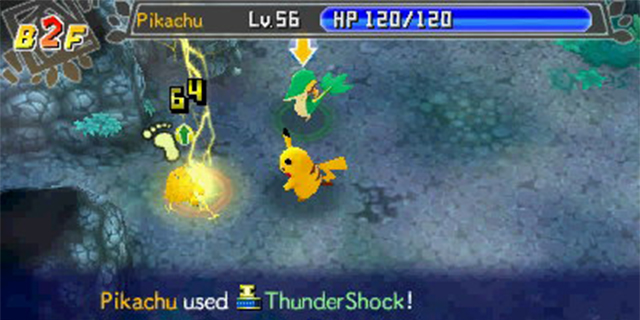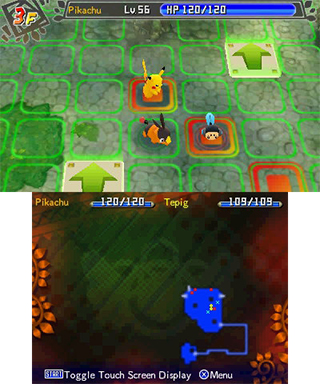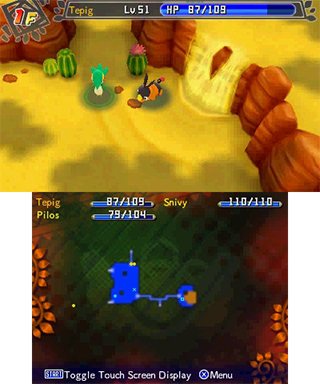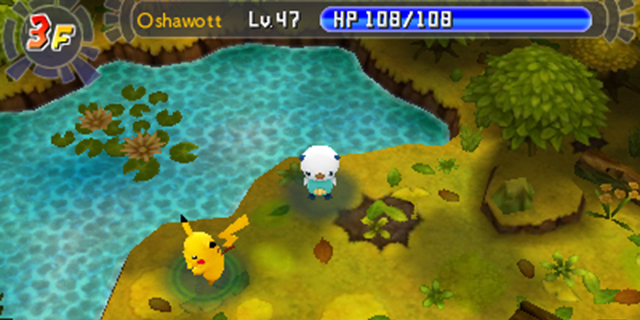
The Pokemon Mystery Dungeon series, once an intriguing mix of two different titles, has at this point become an institution of its own. It was inevitable, I guess; Spike Chunsoft’s long-running Mystery Dungeon gameplay is something at which it has become very experienced, and attaching the super-popular license to it makes for much better sales. That said, Gates to Infinity does represent the largest change in the franchise, both visually and mechanically.
For those who aren’t familiar, the game has you exploring procedurally-generated dungeons, gathering items and fighting off wild enemies as you progress through the dungeon’s floors and reach the objective or boss at the end. In that respect, Gates to Infinity is very similar to its predecessors; everything from party management to diagonal attacks is handled in the same way, and you’re still unable to really control anyone but your protagonist.


This time, you’re given a small subset of starters to choose from: Snivy, Oshawott, Tepig, Pikachu and, for a bit of variety, Axew. Then you choose one of the others as your partner, who becomes an advocate for a “paradise” and your constant companion. This is all an excuse to gather lots of Pokemon, build lots of various buildings in your home base and generally keep taking quests from people.
The dungeons themselves have break areas in which you move freely and can trigger battles. This seems to be included to allow for the kinds of simple traversal puzzles found in many JRPGs; it didn’t feel like a great use of time for development or play. Still, it’s not that bothersome. Even still, the dungeon experience is helped by the elimination of hunger. The Pokemon branch of the Mystery Dungeon games has never been so cutthroat as the originals, and this change lets it further grow into a calmer, friendlier form. In its place comes the item PP mechanic from base Pokemon games, leaving you in trouble without restorative items if you stick around a dungeon too long.

Gates to Infinity is a long game, and the implications of that are conflicting. It’s certainly nice to have a wealth of content to experience, and with all the quests and tasks here, you’ll be exploring for a long time. That said, there are a few things that could have been done to help regarding pacing and tedium. There’s no real way to get through inane conversations any faster, and as the game’s generally written for young children, you’ll want to. Also, the best parts of the game are found near the end of the main quest and afterward, so many of your first hours with the game will be with the worst the game has to offer.
The 3DS features added to the game aren’t that interesting, but they’re there. You can explore “magnagates” with alternate parties by pointing the camera at round things, and bring the spoils back to your adventure. While the variety is nice, any time spent not working on your core team feels like a waste. There’s a StreetPass rescue mechanic implemented, so if you fall in a crucial dungeon, you can get a rescue. Even still, the dungeons aren’t that long, and death has a very small penalty and lets you keep your experience.
The best thing about the 3DS transition, then, is with the visuals. Everything is fully-3D, a change needed after the years of running what was essentially a GBA engine, and the smooth motions and depth effects make things a lot more pleasant. As you may expect from a new-engine game, there were a few things left by the wayside. The most significant? The roster, which only numbers at 150 or so creatures. You won’t be creating your dream party, though there’s still a decent amount of variety to who’s available.
Gates to Infinity doesn’t represent a huge leap forward for the series, but as with every game since the first, playing one of these games can be quite a lot of fun. It may be the next installment that manages to clear the hurdle of making things fresh and new for someone who has already played and tired of one; we certainly hope so. For now, it holds the dubious, temporary distinction of being the best Pokemon game made for the system. Even still, if you’re looking for fresh ideas and similar gameplay, may we suggest checking out The Denpa Men: They Came By Wave first?
Pros: Nice visual makeover, successful game balance tweaks
Cons: Tedium in full force, limited roster, childish writing



















